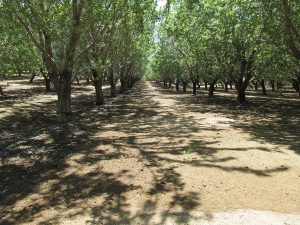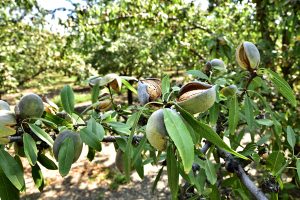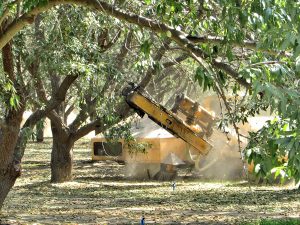
Director, Member Relations
This report covers conditions and observations made between Monday, July 5th and Sunday, July 31st, 2016.
Northern Region –
Growers in the Sacramento Valley received only a slight reprieve from the intense heat experienced in the San Joaquin Valley, farther to the south. Daily maximum temperatures ranged from the upper 80’s to upper 90’s during the first half of the period. Reading’s then climbed above the century mark for the majority of the period’s latter half, with a change in the state’s weather pattern finally allowing temperatures to moderate in the period’s closing days. Morning lows followed the pattern established by the daily maximums, with readings ranging from the upper 50’s to upper 60’s throughout the period.Sacramento Valley growers sent shakers into the most advanced Nonpareil plantings along the west side of the region during the third week of July. While the crop in the earliest orchards has been picked and delivered to huller/sheller facilities, deliveries from the shellers will not be received until the first week of August. Observers are reporting that shaker activity will increase along the I-5 corridor during the coming week, while growers in the Butte County area are completing their final pre-harvest irrigation and will begin shaking by mid-August.
Growers focused on pest management and irrigation during much of July, in anticipation of the approaching harvest. Hull split treatments to control Navel Orange Worm, NOW, have been made, based on “trap counts’ used to monitor the insect’s stage of development. Growers and Pest Control Advisors are reporting that NOW populations are running lower than last year’s levels. This is no doubt the result of improved mummy shaking conditions this year, produced by the better rainfall amounts received during the winter of 2015/16. The wetter conditions resulted in easier removal of the nuts containing over-wintering NOW larvae. This greatly reduces the population in the following growing season, providing for more effective control of the remaining insects, less environmental impacts and reduced crop damage.
Growers have also completed bait applications targeted to specific almond-feeding ant species, timing applications between the irrigation’s required to support the developing crop. Web-spinning mites have not presented significant problems this year and the region’s orchards are in generally good condition, though observers have reported some defoliation in orchards where Scab, a foliar fungal infection has taken hold.
Observers have reported that while harvest operations are just beginning on the Nonpareil and Independence varieties, hulls of the Price and Sonora varieties are also splitting and will follow the Nonpareil closely.
Central Region –
Hot conditions dominated the weather in the central region during July, particularly in the latter half of the month. Daily maximum readings were reported at their most comfortable levels in the mid 80’s to lower 90’s in the period’s opening week. However, readings quickly rose to more challenging levels, with readings ranging from the mid 90’s to as much as 108 degrees for the balance of the period. Morning low temperatures provided only a minimal respite from the daily assault of heat, with readings widely reported between the mid 50’s and upper 60’s.Harvest operations have begun the northern San Joaquin Valley. Growers along the west side of the region sent shakers into the most advanced Nonpareil plantings late in the week of July 17th. Shaking activity increased during the final week of the period and observers are reporting that growers in all areas will begin shaking by the second week of August. Growers with plantings of the Independence variety are also expected to begin shaking within the coming week. Reports of uneven maturity within the Independence have surfaced again this year, prompting growers to ponder the proper timing for shaking as they work to cleanly remove the crop from the trees.
Growers spent much of the period irrigating and preparing for harvest. Treatments for Navel Orange Worm, NOW, were completed, with the actual timing based on observations of pheromone and egg traps set in the orchards. Pest Control Advisors are now monitoring orchards for the next wave of egg laying by female NOW moths, to determine if additional controls are warranted.
After experiencing excessive losses caused by NOW in the 2015 crop, growers and their Pest Control Advisors have focused on reducing the impacts of this perennial insect pest. Better mummy shaking conditions resulting from the beneficial rains received over the past winter have certainly helped. And as shown in the photo accompanying this report, good shell seals in the Nonpareil will also provide an increased degree of protection against infestation. Enhanced shell seal also helps prevent damage from ants while the crop is laying in the ground after shaking.
To this point, web-spinning mites have not been created widespread issues for northern San Joaquin Valley growers. Natural predator populations have kept expansion of this pest in check. However, the hot temperatures have increased stress levels on the trees and promoted increases in mite populations, leading growers to watch their orchards closely. Materials added to hull split NOW treatments have helped prevent explosive increases in mite pressure and growers are hopeful that additional treatments will not be needed.
Vegetation management has also been a critical activity, as growers worked to ensure a smooth, even orchard floor that enables easy movement of the shaken crop while minimizing dust during the harvest. This is best accomplished in most cases by sending flail mowers into the orchards to mow the weed growth closely to the soil surface prior to shaking.
While it is a bit early to tell how the harvest will progress, there are tell-tale signs of what lay ahead. Observers on the west side of the valley have noted hull split in the Sonora, Carmel, Aldrich and Price, as well as on the outside rows of Padre plantings, signs that this year’s harvest may be very compressed with little lag between varieties.
Southern Region –
Growers and their orchards baked under the summer sun in the southern San Joaquin Valley during July as high pressure kept daily temperatures uncomfortably hot. Daily maximum temperatures dipped to their lowest values in the lower 90’s only on the 9th and 19th of July, with highest readings reaching to as high as 108 in the final week of the period. Morning lows provided little relief from the daily high’s with readings reported in the mid 60’s to lower 70’s for much of the period.As may be seen in the accompanying photos, the 2016 harvest has begun. Shakers began their work on the week of July 17th, with sweepers and pickup machines following during the final week of the month.
Some product has been removed from the orchards and huller/sheller operations are expected to begin during the first week of August. Observers are reporting that the pace of harvest operations will quickly reach maximum levels within the coming week.
The past month has found growers throughout the region preparing for the harvest. Irrigation and pest control dominated daily activities. The hot daily temperatures have driven the orchards water requirement higher, forcing growers to balance their orchard’s stress levels. Growers want to impose a degree of water stress at the initiation of hull split as a means of reducing fungal infections on the hulls. However, excessive water stress can adversely impact the trees and the maturing crop.
While there have not been widespread problems with web-spinning mites in the northern San Joaquin, growers in areas of the southern valley have experienced increasing pressure, aggravated by the daily temperatures. Natural predators have failed to keep up with the increasing mite populations, forcing many, particularly in areas of Kern and Tulare counties, to treat to regain control and reduce the potential of defoliating their orchards. Growers throughout the region are also reporting increasing trap catches of Navel Orange Worm, NOW, as a new “flight” of adult NOW moths begin to deposit eggs on the maturing crop.
While the past winter’s rainfall enabled increased water allocations for many southern region growers, a significant proportion of the region remains dependent on groundwater. Observers in Madera County are reporting that while growers there are having fewer difficulties this year, a number are still fighting to maintain adequate water availability for their orchards.
In the event of any significant occurrences prior to that date, this site will be updated as soon as possible.


